The Transformative Impact of Prosthetic Ankle Joints on Rehabilitation
Release Time:
May 25,2025
The Transformative Impact of Prosthetic Ankle Joints on Rehabilitation Table of Contents 1. Introduction to Prosthetic Ankle Joints 2. The Importance of Prosthetic Ankle Joints in Rehabilitation 3. Design and Functionality of Prosthetic Ankle Joints 4. Types of Prosthetic Ankle Joints 4.1 Mechanical Prosthetic Ankle Joints 4.2 Electronic Prosthetic
The Transformative Impact of Prosthetic Ankle Joints on Rehabilitation
Table of Contents
- 1. Introduction to Prosthetic Ankle Joints
- 2. The Importance of Prosthetic Ankle Joints in Rehabilitation
- 3. Design and Functionality of Prosthetic Ankle Joints
- 4. Types of Prosthetic Ankle Joints
- 5. Role of Prosthetic Ankle Joints in Rehabilitation
- 6. Benefits of Using Prosthetic Ankle Joints
- 7. Challenges in Adopting Prosthetic Ankle Joints
- 8. The Future of Prosthetic Ankle Technology
- 9. Frequently Asked Questions
- 10. Conclusion
1. Introduction to Prosthetic Ankle Joints
Prosthetic ankles have become a pivotal component in the world of rehabilitation for those with lower limb amputations. Their innovative designs are not merely functional; they embody a shift towards improving the overall quality of life for users. In recent years, the field has observed significant advancements in technology, enabling prosthetic joints to mimic the natural movement of an ankle more closely. This article delves into the various aspects of prosthetic ankle joints, emphasizing their role in rehabilitation.
2. The Importance of Prosthetic Ankle Joints in Rehabilitation
The rehabilitation process for amputees can be complex and emotionally challenging. **Prosthetic ankle joints** play a fundamental role in restoring mobility and independence. They facilitate activities of daily living, including walking, running, and participating in sports, which are crucial for physical and mental health. By providing stability and support, these devices help users regain their confidence and reintegrate into society.
3. Design and Functionality of Prosthetic Ankle Joints
The design of prosthetic ankle joints is a testament to the intersection of engineering, medicine, and user experience. They are designed to mimic the biomechanical functionality of a natural ankle. Effective design involves balancing **flexibility**, **stability**, and **weight** to ensure comfort and ease of use. The materials used range from lightweight metals to advanced polymers, all aimed at optimizing performance and user comfort.
3.1 Biomechanical Considerations
Understanding the biomechanics of human gait is crucial in the design of prosthetic ankle joints. They need to support the weight of the user while allowing for **natural motion** during walking and running. An effective prosthetic ankle must accommodate various terrains and activities, ensuring that users can navigate both flat surfaces and inclines.
3.2 User-Centric Design
User experience is paramount in the design process. Prosthetic joints must fit comfortably and allow for a range of motion while being easy to put on and take off. Comfort features, such as cushioning and adjustable components, are essential for long-term use.
4. Types of Prosthetic Ankle Joints
Prosthetic ankle joints are categorized based on their functionality and technology. Understanding these types helps users make informed decisions regarding their rehabilitation needs.
4.1 Mechanical Prosthetic Ankle Joints
Mechanical prosthetic ankles operate without electronic components. They rely on springs and hinges to provide **movement and support**. These devices tend to be more affordable and are suitable for users with limited mobility needs.
4.2 Electronic Prosthetic Ankle Joints
Electronic prosthetic joints utilize sensors and motors to adapt to different terrains and walking speeds. They automatically adjust to provide optimal support, mimicking the natural biomechanics of a healthy ankle. This advanced technology enhances mobility, making it easier for users to engage in various activities.
4.3 Hybrid Prosthetic Ankle Joints
Hybrid prosthetic joints combine mechanical and electronic components, offering a balance between functionality and adaptability. This type provides users flexibility in their movements while ensuring durability.
5. Role of Prosthetic Ankle Joints in Rehabilitation
The integration of prosthetic ankle joints into rehabilitation programs has proven to be beneficial in several ways. They facilitate the development of strength, balance, and coordination, allowing users to engage in physical therapy more effectively.
5.1 Enhancing Mobility
Prosthetic ankle joints significantly enhance mobility for amputees. They allow users to walk with a more natural gait, which is essential for balance and coordination. Enhanced mobility encourages users to participate in daily activities, boosting their physical health and overall well-being.
5.2 Psychological Benefits
The ability to move freely and engage in social interactions has profound psychological effects. Users who successfully adapt to their prosthetic ankle joints often experience improved self-esteem and a more positive outlook on life. Rehabilitation programs that incorporate these devices foster a sense of normalcy and independence.
6. Benefits of Using Prosthetic Ankle Joints
The advantages of prosthetic ankle joints extend beyond mere mobility. They contribute to physical, emotional, and social aspects of an individual's life.
6.1 Improved Quality of Life
The ability to perform everyday tasks without assistance enhances the quality of life for amputees. Prosthetic ankle joints empower users to regain control over their lives, leading to greater satisfaction and happiness.
6.2 Increased Physical Activity
With the right prosthetic ankle joint, users can engage in various physical activities, from walking and jogging to participating in sports. This increased activity level contributes to better physical health, including weight management and cardiovascular fitness.
6.3 Customization and Personalization
Modern prosthetic ankle joints can be customized to meet individual needs, ensuring a better fit and greater comfort. This personalization helps users feel more at ease with their devices, leading to higher satisfaction and adherence to rehabilitation protocols.
7. Challenges in Adopting Prosthetic Ankle Joints
Despite their numerous benefits, the adoption of prosthetic ankle joints is not without challenges. Understanding these challenges can help in developing better support systems for users.
7.1 Physical Adaptation
Adapting to a prosthetic ankle joint can be physically demanding. Some users may experience discomfort or difficulty in adjusting to the device, necessitating comprehensive training and support.
7.2 Financial Considerations
The cost of advanced prosthetic ankle joints can be a barrier for many individuals. Insurance coverage varies, and many users may find themselves facing significant out-of-pocket expenses.
7.3 Accessibility of Resources
Access to trained professionals and rehabilitation centers that specialize in prosthetic technology can be limited in some regions. This can hinder effective rehabilitation and adaptation for users.
8. The Future of Prosthetic Ankle Technology
The future of prosthetic ankle joints holds great promise with the advent of new technologies. Innovations in materials, sensors, and artificial intelligence are set to revolutionize how these devices function and interact with their users.
8.1 Advanced Materials and Designs
Research into new materials promises lighter, more durable prosthetic joints that can withstand greater stress while offering better comfort. The development of smart materials that adjust to the user’s needs in real-time is also on the horizon.
8.2 Integration of AI and Machine Learning
Artificial intelligence can enhance the functionality of prosthetic joints by learning from users’ movements and preferences. Machine learning algorithms can help devices adapt seamlessly to various activities, improving performance and user experience.
9. Frequently Asked Questions
What are prosthetic ankle joints made of?
Prosthetic ankle joints are typically crafted from a blend of lightweight metals, polymers, and advanced materials designed for durability and comfort.
How do prosthetic ankle joints improve mobility?
These joints mimic the natural movement of an ankle, providing support and stability that allows users to walk, run, and engage in physical activities effectively.
Are there different types of prosthetic ankle joints?
Yes, there are three main types: mechanical, electronic, and hybrid prosthetic ankle joints, each with its own set of advantages.
How can I choose the right prosthetic ankle joint?
Choosing the right prosthetic ankle joint involves consulting with a prosthetist who can assess your needs, lifestyle, and physical condition to recommend the best option.
What role do physical therapists play in rehabilitation with prosthetic ankle joints?
Physical therapists provide essential guidance on adapting to new prosthetics, helping users develop strength, balance, and coordination to maximize their mobility.
10. Conclusion
Prosthetic ankle joints play an invaluable role in the rehabilitation of individuals with lower limb amputations. Their advanced design and functionality not only facilitate improved mobility but also foster a sense of independence and confidence. As technology continues to evolve, the potential for these devices to transform the lives of users grows exponentially. Embracing the benefits of prosthetic ankle joints can lead to a brighter, more active future for amputees, empowering them to reclaim their lives and pursue their passions.
Keywords:
You Can Also Learn More About Industry Trends






